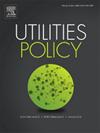欧洲和美国解决能源贫困的方法:分类和评估设计策略
IF 4.4
3区 经济学
Q3 ENERGY & FUELS
引用次数: 0
摘要
随着气候变化加速,以及最近的健康、能源和通货膨胀危机加剧了更广泛的不平等趋势,确保获得充足和负担得起的能源服务变得越来越重要。在本文中,我们对欧洲和美国的能源贫困政策和方案设计进行了深入的回顾。我们根据四类政策选择对不同的方法进行分类和评估:援助、目标、资助和治理。我们讨论了在这两种情况下采用的方法的优点和缺点,提取了关键的经验教训,并提出了提高能源援助政策有效性的建议。这里提出的分类法并不打算作为评估程序有效性的工具。相反,它的目的是帮助我们理解具体的设计决策是如何影响项目结果的。本文章由计算机程序翻译,如有差异,请以英文原文为准。
European and US approaches to energy poverty: Classifying and evaluating design strategies
As climate change accelerates and recent health, energy, and inflation crises exacerbate broader inequality trends, ensuring adequate and affordable access to energy services is becoming increasingly important. In this paper, we conduct an in-depth review of energy poverty policy and program design in Europe and the United States. We classify and evaluate different approaches according to four categories of policy choices: assistance, targeting, funding, and governance. We discuss the advantages and disadvantages of the approaches adopted in both contexts, extract key lessons, and provide recommendations to improve the effectiveness of energy assistance policies. The taxonomy presented here is not intended as a tool for evaluating program effectiveness. Instead, it is meant to help us understand how specific design decisions may impact program outcomes.
求助全文
通过发布文献求助,成功后即可免费获取论文全文。
去求助
来源期刊

Utilities Policy
ENERGY & FUELS-ENVIRONMENTAL SCIENCES
CiteScore
6.80
自引率
10.00%
发文量
94
审稿时长
66 days
期刊介绍:
Utilities Policy is deliberately international, interdisciplinary, and intersectoral. Articles address utility trends and issues in both developed and developing economies. Authors and reviewers come from various disciplines, including economics, political science, sociology, law, finance, accounting, management, and engineering. Areas of focus include the utility and network industries providing essential electricity, natural gas, water and wastewater, solid waste, communications, broadband, postal, and public transportation services.
Utilities Policy invites submissions that apply various quantitative and qualitative methods. Contributions are welcome from both established and emerging scholars as well as accomplished practitioners. Interdisciplinary, comparative, and applied works are encouraged. Submissions to the journal should have a clear focus on governance, performance, and/or analysis of public utilities with an aim toward informing the policymaking process and providing recommendations as appropriate. Relevant topics and issues include but are not limited to industry structures and ownership, market design and dynamics, economic development, resource planning, system modeling, accounting and finance, infrastructure investment, supply and demand efficiency, strategic management and productivity, network operations and integration, supply chains, adaptation and flexibility, service-quality standards, benchmarking and metrics, benefit-cost analysis, behavior and incentives, pricing and demand response, economic and environmental regulation, regulatory performance and impact, restructuring and deregulation, and policy institutions.
 求助内容:
求助内容: 应助结果提醒方式:
应助结果提醒方式:


